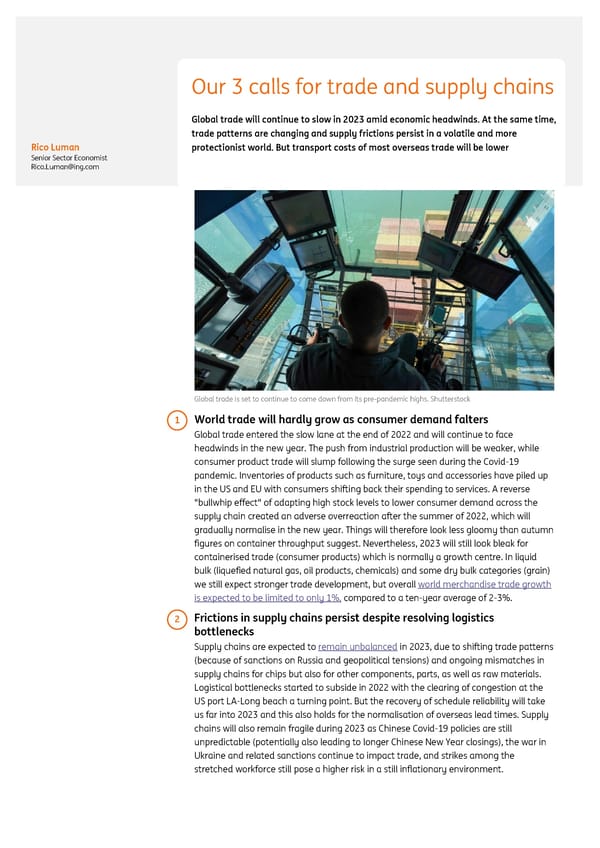ING global economic outlook 2023 December 2022 Our 3 calls for trade and supply chains Global trade will continue to slow in 2023 amid economic headwinds. At the same time, trade patterns are changing and supply frictions persist in a volatile and more Rico Luman protectionist world. But transport costs of most overseas trade will be lower Senior Sector Economist [email protected] Global trade is set to continue to come down from its pre-pandemic highs. Shutterstock 1 World trade will hardly grow as consumer demand falters Global trade entered the slow lane at the end of 2022 and will continue to face headwinds in the new year. The push from industrial production will be weaker, while consumer product trade will slump following the surge seen during the Covid-19 pandemic. Inventories of products such as furniture, toys and accessories have piled up in the US and EU with consumers shifting back their spending to services. A reverse "bullwhip effect" of adapting high stock levels to lower consumer demand across the supply chain created an adverse overreaction after the summer of 2022, which will gradually normalise in the new year. Things will therefore look less gloomy than autumn figures on container throughput suggest. Nevertheless, 2023 will still look bleak for containerised trade (consumer products) which is normally a growth centre. In liquid bulk (liquefied natural gas, oil products, chemicals) and some dry bulk categories (grain) we still expect stronger trade development, but overall world merchandise trade growth is expected to be limited to only 1%, compared to a ten-year average of 2-3%. 2 Frictions in supply chains persist despite resolving logistics bottlenecks Supply chains are expected to remain unbalanced in 2023, due to shifting trade patterns (because of sanctions on Russia and geopolitical tensions) and ongoing mismatches in supply chains for chips but also for other components, parts, as well as raw materials. Logistical bottlenecks started to subside in 2022 with the clearing of congestion at the US port LA-Long beach a turning point. But the recovery of schedule reliability will take us far into 2023 and this also holds for the normalisation of overseas lead times. Supply chains will also remain fragile during 2023 as Chinese Covid-19 policies are still unpredictable (potentially also leading to longer Chinese New Year closings), the war in Ukraine and related sanctions continue to impact trade, and strikes among the stretched workforce still pose a higher risk in a still inflationary environment.
 ING Global Economic Outlook 2023 Page 16 Page 18
ING Global Economic Outlook 2023 Page 16 Page 18